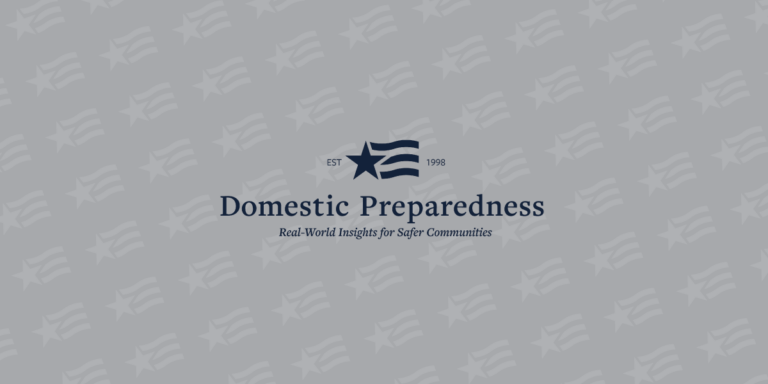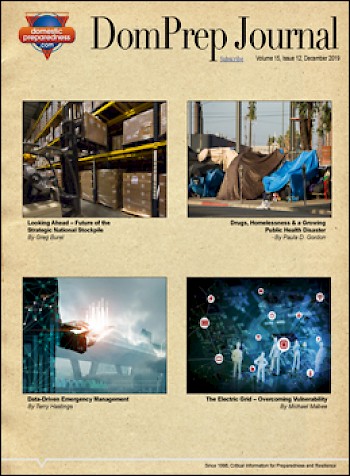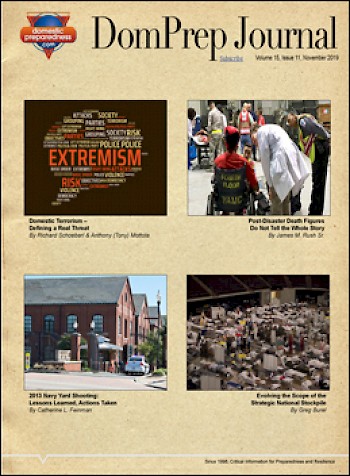
Author Archive

Ready or Not provides an annual assessment of states’ level of readiness to respond to public health emergencies and recommends policy actions to ensure that everyone’s health is protected during such events. This 2020 edition reports overall preparedness improvement but also identifies areas that need attention. https://www.tfah.org/wp-content/uploads/2020/01/2020ReadyOrNotFINAL.pdf

January 2020
Domestic Preparedness
January 29, 2020
Featured in this issue: Publisher’s Message, By Martin (Marty) Masiuk; Ever-Evolving Preparedness Challenges, By Catherine L. Feinman; Small Steps Toward Long-Term Power Outage Preparedness, By Deborah Link; Triggered Collapse, Part 1: A Nation Unprepared, By Drew Miller; Complex Coordinated Terrorist Attacks: Paris Attacks of 2015, By Robert Mueck; Family Child

National Incident Management System–National Qualification System Supplemental Guide for Coaches and Evaluators
Domestic Preparedness
January 6, 2020
The National Qualification System (NQS) establishes and promotes baseline qualifications for a national incident workforce consisting of incident management, incident support, and emergency management personnel. This National Incident Management System (NIMS) Supplemental Guide for Coaches and Evaluators is a supplemental NQS guide that defines the roles coaches and evaluators play

National Advisory Council Report to the FEMA Administrator–November 2019
Domestic Preparedness
January 4, 2020
Members of the Federal Emergency Management Agency’s (FEMA) National Advisory Council presented a report to Acting FEMA Administrator Pete Gaynor outlining actions the agency can take to address key issues facing the field of emergency management. The council passed 31 recommendations, which included input from a broad range of stakeholders

December 2019
Domestic Preparedness
December 25, 2019
Featured in this issue: Creating the Problem, Then Solving It, By Catherine L. Feinman; Looking Ahead – Future of the Strategic National Stockpile, By Greg Burel; Drugs, Homelessness & a Growing Public Health Disaster, By Paula D. Gordon; Data-Driven Emergency Management, By Terry Hastings; The Electric Grid – Overcoming Vulnerability,

2019 National Preparedness Report
Domestic Preparedness
December 9, 2019
The National Preparedness Report evaluates annual preparedness progress and challenges facing the whole community. The 2019 National Preparedness Report highlights the diverse range of preparedness challenges the Nation faces—from terrorism and active shooter incidents, to cyberattacks, to natural disasters, as well as how stakeholders across the nation are using preparedness

A Guide to Critical Infrastructure Security and Resilience
Domestic Preparedness
December 5, 2019
The U.S. Department of State and the U.S. Department of Homeland Security’s (DHS) Cybersecurity and Infrastructure Security Agency (CISA) developed this guide to serve as an overview of the U.S. all-hazards approach to critical infrastructure security and resilience. It is intended for both domestic and international partners. https://www.cisa.gov/sites/default/files/publications/Guide-Critical-Infrastructure-Security-Resilience-110819-508v2.pdf

November 2019
Domestic Preparedness
November 27, 2019
Featured in this issue: Laying the Groundwork for Combating Future Threats, By Catherine L. Feinman; Domestic Terrorism – Defining a Real Threat, By Richard Schoeberl & Anthony (Tony) Mottola; Post-Disaster Death Figures Do Not Tell the Whole Story, By James M. Rush Sr.; 2013 Navy Yard Shooting: Lessons Learned, Actions

Protecting America’s Schools: A U.S. Secret Service Analysis of Targeted School Violence
Domestic Preparedness
November 25, 2019
The U.S. Secret Service National Threat Assessment Center (NTAC) studied 41 incidents of targeted school violence that occurred at K-12 schools in the United States from 2008 to 2017. This report offers an in-depth analysis of the motives, behaviors, and situational factors of the attackers, as well as the tactics,

Disaster Recovery Reform Act (DRRA) Annual Report – October 2019
Domestic Preparedness
November 18, 2019
This report provides an overview of the Disaster Recovery Reform Act (DRRA), highlights its alignment with the Federal Emergency Management Agency’s (FEMA) strategic goals, and describes FEMA’s efforts to implement the law. https://www.fema.gov/media-library-data/1573222648380-b2fc54c82eb3b03c0724cbc696a94613/DRRAAnnualReport_FINAL_PUBLISHED.pdf
Follow Us
Get Instant Access
Subscribe today to Domestic Preparedness and get real-world insights for safer communities.
ARchives
Article Out Loud – Benefits of Industrial Liaisons: A Harris County Example
January 11, 2023
Planners in the Harris County area are successful specifically because of the relationships they have built over many years. For example, the county’s Industrial Liaisons Program provides many positive takeaways and best practices practitioners can implement throughout the U.S. and abroad.
Article Out Loud – Building Design for Safety and Resilience – First Steps
January 11, 2023
An all-hazards design process considers the function of the building during normal operations as well as the safety of the occupants and the surrounding community against possible risks and threats. Like layers of an onion, effective security should take a multi-layered approach. Safety and security do not need to be
Article Out Loud – Not All Preparedness Grants Are Identical
January 10, 2023
A distinguished national officer of the International Association of Emergency Managers provides a short but concise list of helpful recommendations that grant-seekers at all levels of government, and in the private sector, might be well advised to follow in preparing, reviewing, submitting, and following up on their own grant applications.
Article Out Loud – ‘Game Day’ Food Defense: Enhanced Business as Usual
January 10, 2023
With more than 40 Olympic venues serving an estimated 14 million meals, the 2012 London Olympic Games were susceptible to many potential foodborne illnesses – both intentional and unintentional. However, through education, communications, surveillance, and a focus on surge capacity, London provided a model that could help protect the food
Article Out Loud – How One Town Stood Up to a Category 4 Storm
January 4, 2023
When Category 4 Hurricane Ian crossed Florida in September 2022, more than 4 million Florida homes and businesses lost power. However, one town kept the lights on and was spared the devastation the cities surrounding it faced. With resilience and sustainability in mind, this author shares the planning involved in
Article Out Loud – Beachie Creek Fire – A Practitioner’s Firsthand Account
January 4, 2023
When disaster strikes, sometimes those trained to respond find themselves and their families fleeing from the fire. Once their families are safe, they jump back in to assist wherever needed. This scenario happened to one emergency manager when the Beachie Creek wildfire engulfed surrounding Oregon communities with little warning.
Article Out Loud – Redirecting Dual-Use Research Regulations
January 3, 2023
Life science research benefits society in many ways, but also creates certain risks – particularly when that research falls into the wrong hands, either deliberately or unintentionally. Clearly defined rules and regulations governing the results of such dual-use research could help keep scientific research focused on less dangerous and more
Article Out Loud – Preparing for & Responding to Disaster – A 2018 Review
January 3, 2023
Fire, wind, and water – a lot of water. The year 2018 delivered all in a series of natural disasters that seemed almost continual. Throughout the year, there was a significant risk to lives and property caused by wildfires in the West, hurricanes in the Southeast, and flooding in numerous
Article Out Loud – How Technology Systems Impact Critical Infrastructure
December 21, 2022
Operational technology systems that run many critical infrastructure functions are becoming more dependent on information technology. As these worlds converge, emergency preparedness professionals must address the related security challenges. This article shares some lessons learned and uses a foundational knowledge of the topic to inspire possible solutions.
Article Out Loud – The Importance of Strong Leadership for a Unique Discipline
December 21, 2022
A transformational leadership style can help bridge relationship and communication gaps between leaders and other community stakeholders. Learn how one young deputy fire chief learned from his past leadership missteps and honed his meta-leadership skills, which were essential in reconnecting communities when he became a state emergency manager.
Follow Us
Get Instant Access
Subscribe today to Domestic Preparedness and get real-world insights for safer communities.


